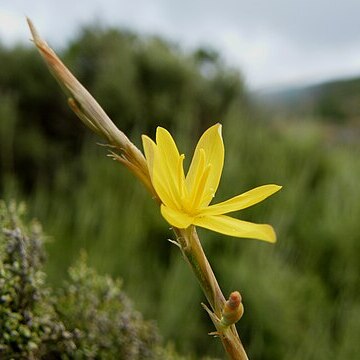Plants variable in size, 120-850 mm high. Corm 13-18 mm diam., or larger if surrounded by accumulated tunic layers; tunics of coarse, dark brown to blackish fibres. Stem with simple or with 1 to 3(6) long, diverging secondary branches, straight to slightly flexuose, bearing sessile lateral rhipidia at upper nodes, each partly to almost entirely enclosed by subtending sheathing leaf, usually as long or longer than rhipidia. Foliage leaves usually (1)2 or 3(4), ± basal, linear, ascending, longer than stem, trailing distally, channelled with margins curving inward, occasionally loosely coiled above. Rhipidial spathes partly to entirely dry and pale at anthesis, attenuate, inner 22-30(-37) mm long, 1/2-2/3 as long. Flowers fugaceous, rotate, pale yellow, with tepals united below in a closed tube, upright or secund, evidently odourless, tepal limbs with deeper yellow nectar guides at bases; perianth tube cylindric, narrow, usually slightly curving outward, 4-7(-9) mm long, usually included; tepals 14-25 (subsp. virgata), 23-32 (subsp. karooica) mm long, with short, erect claws 1.0-1.5 mm long, limbs extended horizontally, 4-8(-11) mm wide; outer larger, lanceolate to ovate, inner lanceolate to wedge-shaped. Filaments 3.3-6.0 mm long, united for 1-2 mm; anthers initially 6-9 mm long, yellow; pollen yellow. Ovary 8-16(-20) mm long, upper 1-2 mm a narrow, sterile beak, cylindric, included, on pedicels 5-6 mm long; style branches divided almost to base in paired filiform arms 5-6 mm long, extending horizontally. Capsules narrowly ellipsoid, shortly beaked, 9-13 x 2-3 mm (subsp. virgata), or 16-22 x 4 mm (subsp. karooica), only 1 (rarely 2) developed in each rhipidium. Seeds narrowly angular, 1-2 x 0.7-1.0 mm.
More
Perennial herb, geophyte, 0.20-0.85 m high; corm with tunics of coarse, dark brown to blackish fibres; stem with one main axis or with 1-3 diverging, secondary branches, straight or slightly flexuose. Leaves (1)2 or 3(4), linear, ascending, trailing distally, canaliculate, margins curving inwards. Spathe usually herbaceous, attenuate. Inflorescence a spike; flowers stellate, pale yellow; nectar guides deep yellow; perianth tube cylindric, narrow, slightly curved outward; tepals spreading, 14-32 mm long; outer lanceolate to ovate; inner lanceolate to cuneate. Stamens: filaments 3.3-6.0 mm long, united for 1-2 mm; anthers 6-9 mm long. Ovary sessile, cylindric; style with 6 filiform arms extending between filaments. Flowering time Sept.-Jan. Capsule narrowly ellipsoid.
Cormous geophyte, 200-850 mm tall. Leaves 2 or 3, linear, channelled, trailing above. Flowers pale to deep yellow, tepals forming a tube below and ovary subsessile. Capsules enclosed in the spathes. Mainly Sept.-Nov.
Cormous geophyte, 20-85 cm. Leaves 2 or 3, linear, channelled and trailing. Flowers pale to deep yellow, tepals forming a tube below and ovary subsessile. Capsules narrowly ellipsoid, enclosed in spathes.
A herb. It is a corm or bulb plant. It keeps growing from year to year. It grows 20-85 cm tall. There are 2 or 3 narrow leaves. The flowers are yellow.

